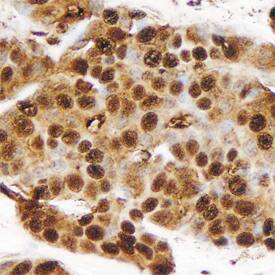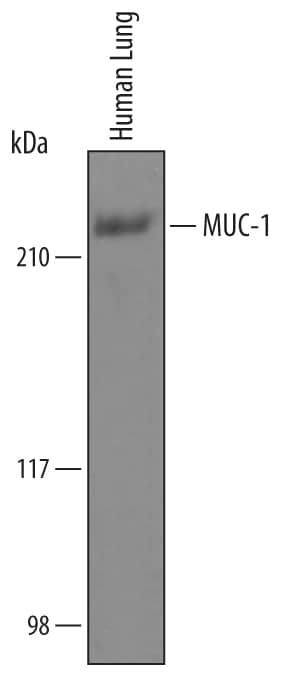Human MUC-1 Antibody
R&D Systems, part of Bio-Techne | Catalog # AF6298

Key Product Details
Species Reactivity
Validated:
Cited:
Applications
Validated:
Cited:
Label
Antibody Source
Product Specifications
Immunogen
Pro126-Arg145
Accession # P15941
Specificity
Clonality
Host
Isotype
Scientific Data Images for Human MUC-1 Antibody
Detection of Human MUC‑1 by Western Blot.
Western blot shows lysates of human lung tissue. PVDF Membrane was probed with 1 µg/mL of Sheep Anti-Human MUC-1 Antigen Affinity-purified Polyclonal Antibody (Catalog # AF6298) followed by HRP-conjugated Anti-Sheep IgG Secondary Antibody (Catalog # HAF016). A specific band was detected for MUC-1 at approximately 230 kDa (as indicated). This experiment was conducted under reducing conditions and using Immunoblot Buffer Group 1.MUC‑1 in Human Breast.
MUC-1 was detected in immersion fixed paraffin-embedded sections of human breast using Sheep Anti-Human MUC-1 Antigen Affinity-purified Polyclonal Antibody (Catalog # AF6298) at 10 µg/mL overnight at 4 °C. Tissue was stained using the Anti-Sheep HRP-DAB Cell & Tissue Staining Kit (brown; Catalog # CTS019) and counterstained with hematoxylin (blue). Specific staining was localized to nuclei and cytoplasm in epithelial cells. View our protocol for Chromogenic IHC Staining of Paraffin-embedded Tissue Sections.Applications for Human MUC-1 Antibody
Immunohistochemistry
Sample: Immersion fixed paraffin-embedded sections of human breast
Western Blot
Sample: Human lung tissue
Formulation, Preparation, and Storage
Purification
Reconstitution
Formulation
Shipping
Stability & Storage
- 12 months from date of receipt, -20 to -70 °C as supplied.
- 1 month, 2 to 8 °C under sterile conditions after reconstitution.
- 6 months, -20 to -70 °C under sterile conditions after reconstitution.
Background: MUC-1
MUC-1 (Mucin-1; also episialin, MAM-6, PEM and PUM) is a 150-450 kDa type I transmembrane glycoprotein that belongs to the Mucin family of molecules. It forms a protective barrier against microbes on the apical surface of most glandular epithelium, and becomes prominently displayed on tumor cells. Mature human MUC-1 is 1232 amino acids (aa) in length. It contains an 1135 aa extracellular domain (ECD) (aa 24-1158), and a signal transducing 73 aa cytoplasmic tail (aa 1182-1255). The ECD is highly polymorphic as evidenced by a highly variable number of 20 aa O-glycosylated tandem repeats. Intracellular processing cleaves MUC-1 between Gly1097 and Ser1098, generating a noncovalently linked heterodimer that is expressed on the cell surface. The C-terminus is 22-25 kDa in size, while the N-terminus is highly variable (70-400 kDa in size), a function of the number of resident tandem repeats. Cell surface processing by TACE releases a soluble ECD fragment of variable MW. There are multiple splice variants that show massive reductions in the size of the ECD. Over aa 126-145, human MUC-1 shares < 50% aa identity with mouse MUC-1. When compared to human, mouse MUC-1 is found not to be polymorphic and possess poorly conserved tandem repeat sequences.
Long Name
Alternate Names
Entrez Gene IDs
Gene Symbol
UniProt
Additional MUC-1 Products
Product Documents for Human MUC-1 Antibody
Product Specific Notices for Human MUC-1 Antibody
For research use only

